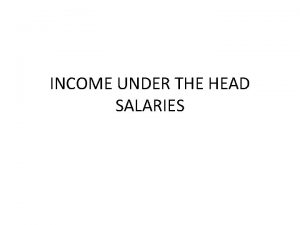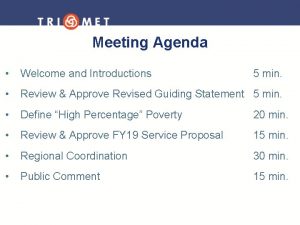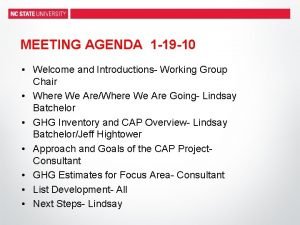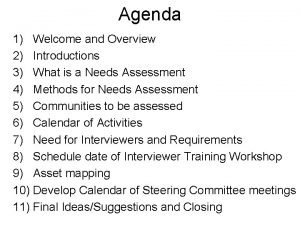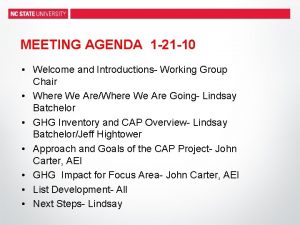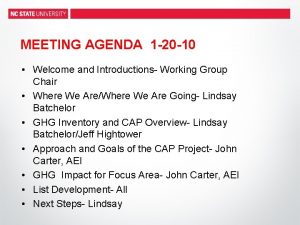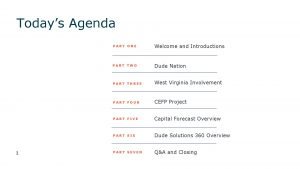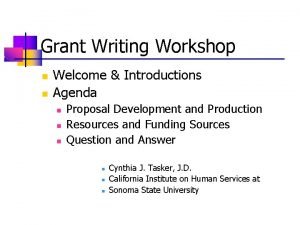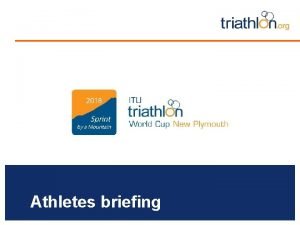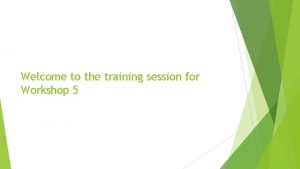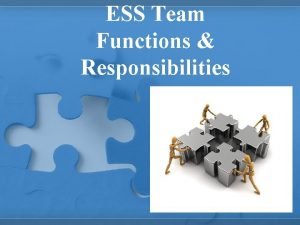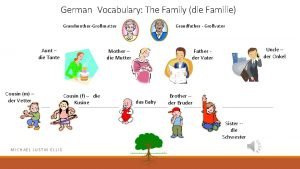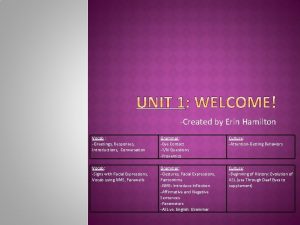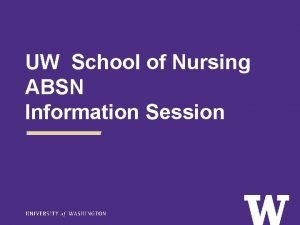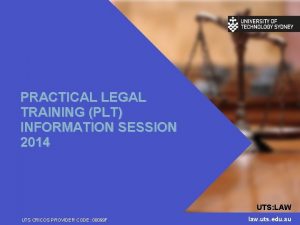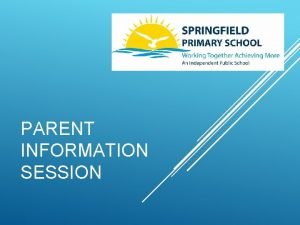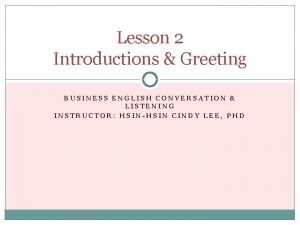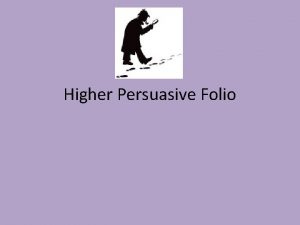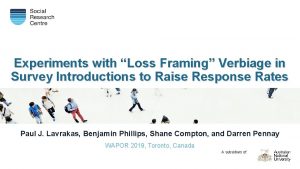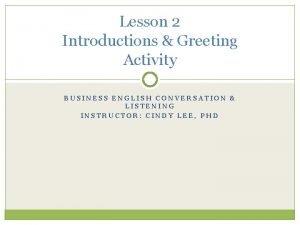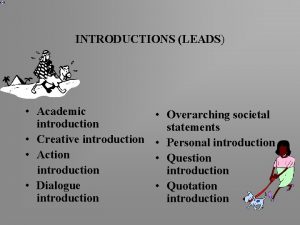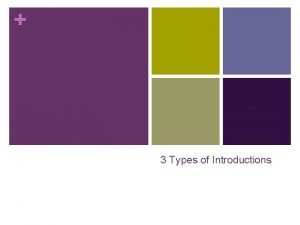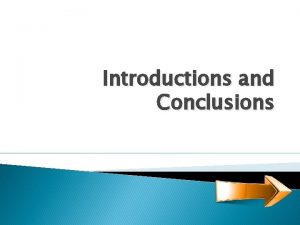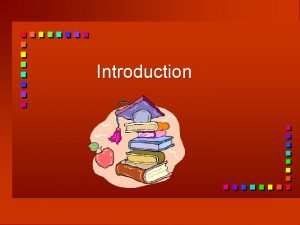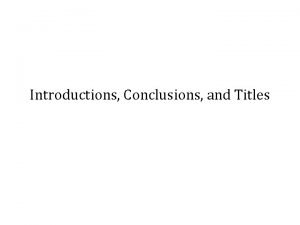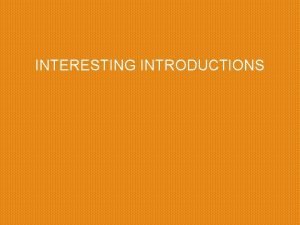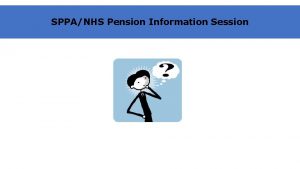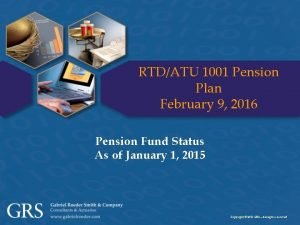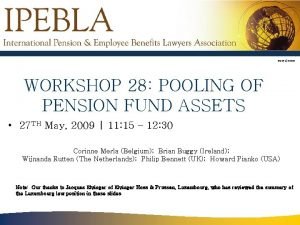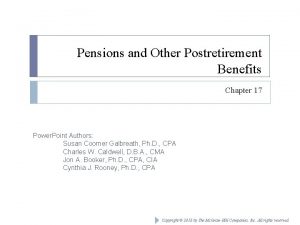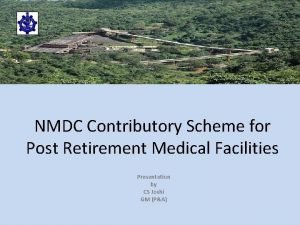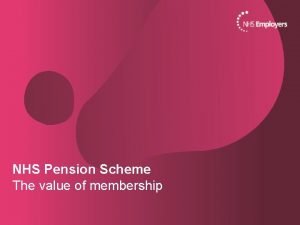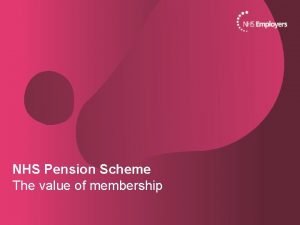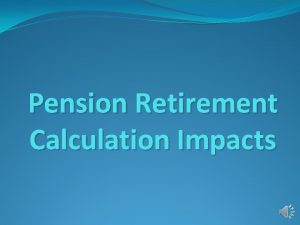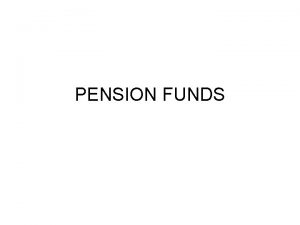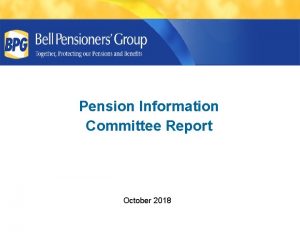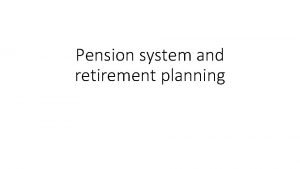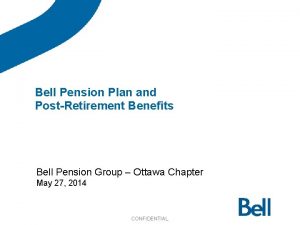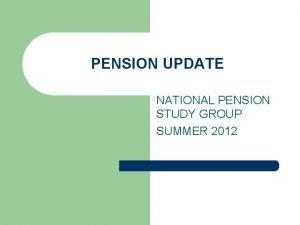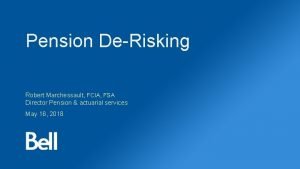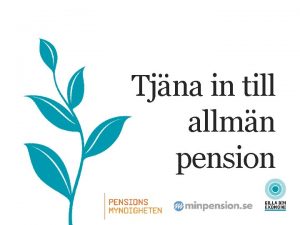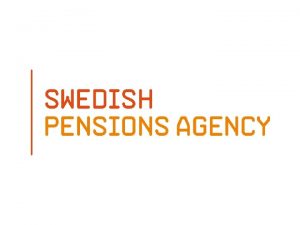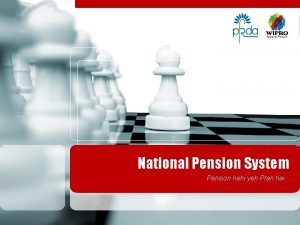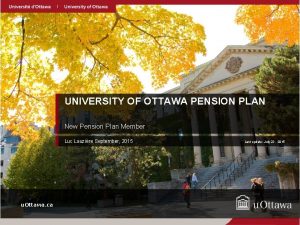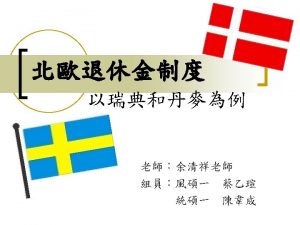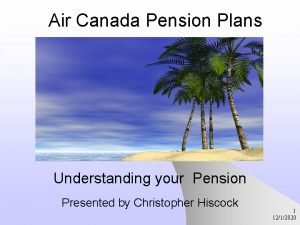SPPANHS Pension Information Session Welcome and Introductions Joe















































- Slides: 47

SPPA/NHS Pension Information Session

Welcome and Introductions Joe Quinn – NHS Staff Benefits Graeme Inglis – Director at Create and Prosper Financial Serviced Ltd, Independent Chartered Financial Planner Pension Transfer Qualified adviser Chris Mc. Leod – Financial Planner, Create and Prosper Financial Services Ltd -----------------------Housekeeping

Why Are You Here…… Core Briefs and word of mouth

Our brief To deliver information sessions relating to pension tax charges and REC Fairly wide scope………. These sessions are generic, if you need specific Financial Advice speak to a Financial Adviser To be independent and impartial

The Spirit of Tonight Other similar sessions to tonight are likely to cover similar ground Respectful discussion is welcomed and encouraged If we do not have an answer to a question tonight we will revert back to you as soon as we can Tonight we will be discussing generic information and not be addressing personal issues – this can be done on a 1 to 1 basis

Framework SPPA/NHS Pension Schemes - How They Work/Overview The Annual Allowance and Tapered Annual Allowance The Lifetime Allowance Tax Charges How Scheme Pays works Protections

Background to The Session NHS employees hit with large/unexpected tax bills Information overload/rumours Many are unaware of where or who to turn to Your employer is not allowed to provide Financial Advice Rules are from HMRC not SPPA

Some Sources of Information SPPA – pensions. gov. scot/nhs Mypension – mypension. sppa. gov. uk BMA – bma. org. uk HMRC – gov. uk Pensionwise – pensionwise. gov. uk Word of mouth/rumours/forums/blogs/internet Applying general information to your personal situation Some of the media

The SPPA Pension – Different Schemes 1995 scheme – If joined before 1/4/08 1/80 th of final pensionable pay and 3/80 ths tax free lump sum 2008 scheme – 1/60 th with no automatic lump sum 2015 scheme – CARE 1/54 th with no automatic lump sum. Accrual of CPI plus 1. 5% per year

The SPPA Pension – Contribution Rates Employer contribution 20. 9% of pensionable earnings Employee contribution rates - Tier Column 1 Pensionable earnings band Column 2 Contribution percentage rate 1 2 3 4 5 6 Up to £ 17, 864 £ 17, 865 to £ 23, 596 £ 23, 597 to £ 29, 904 £ 29, 905 to £ 55, 986 £ 55, 987 to £ 79, 404 £ 79, 405 to £ 116, 360 5. 2% 5. 8% 7. 3% 9. 5% 12. 7% 13. 7% 7 £ 116, 361 and above 14. 7%

The SPPA Pension – Where Are We Now Concerns about tax charges Rumours and mistrust of the pension system Lack of control for scheme members Why should I work? Reducing hours? Opting out? Temporary Fix – from 1 st December 2019 until 31 st March 2020 (REC) Any longer term changes require the consent of HM Treasury

The Annual Allowance £ 40, 000 for 2019/20 tax year but can taper down to £ 10, 000 depending on income For Defined Benefit pension schemes (e. g. SPPA/NHS) – this applies to the increase in value of someone’s pension benefits using “deemed growth rate” For Defined Contribution pension schemes (e. g. AVC/Personal Pension) – contribution level The Annual Allowance includes the total of all individual contributions, employer contributions plus any third party contributions into someone’s pension When the Annual Allowance is exceeded during a single year, a tax charge is applied on excess

The Annual Allowance Just to make things more complicated, an individual’s annual allowance isn’t always £ 40, 000 The level depends on whether an individual has accessed their pension benefits flexibly (in which case their allowance is reduced to £ 4, 000) – Money Purchase Annual Allowance applies Someone’s adjusted income is over £ 150, 000 and their threshold income is over £ 110, 000 - the Tapered Annual Allowance then applies - By earning over £ 150, 000, your individual annual allowance will reduce by £ 1 for every £ 2 of adjusted income over £ 150, 000 (down to an absolute minimum AA of £ 10, 000)

The Tapered Annual Allowance Threshold Income of £ 110, 000 Includes - • Total income, including salary sacrifice pension arrangements • Deducts • Any individual pension contributions made during the tax year • Certain taxable reliefs – i. e. charitable donations made

The Tapered Annual Allowance Adjusted Income of £ 150, 000 Includes Taxable Income (see Threshold Income) Any employer contributions made to a pension (including salary sacrifice) Any built up Final Salary benefits, excluding the cost of individual contributions Deducts Certain charitable donations i. e. gift aid

The Tapered Annual Allowance If Threshold Income is not breached (£ 110, 000) Tapering does not apply, even is Adjusted Income is over £ 150, 000. However if in excess of £ 40, 000 Annual Allowance limit you may still receive a tax bill If you exceed Adjusted Income If over Annual Allowance – no tax relief on contributions over that limit and you will be faced with an annual allowance charge. Annual Allowance charge added to your taxable income for the tax year in question when determining your tax liability. If Annual Allowance charge is over £ 2, 000, you can ask your pension scheme to pay the charge from your benefits. This means your pension scheme benefits would be reduced. You may be able to carry forward any unused annual allowances from the previous three tax years, to reduce or eliminate annual allowance charge completely.

The Annual Allowance – Example 1 Worker aged 55 (DOB 01/12/1964) , started in NHS 30 years ago (01/12/1989), inflation is assumed to be 2%, salary at start of period was £ 80, 000 and £ 81, 000 at the end of the period. Beginning of period – 29 years service, therefore 29/80 x £ 80, 000 = £ 29, 000 Uprate for inflation (x 1. 02) = £ 29, 580 Lump Sum 3 x £ 29, 580 = £ 88, 740 At end of period -30 years service, therefore 30/80 x £ 81, 000 = £ 30, 375 Lump sum 3 x £ 30, 375 = £ 91, 125

The Annual Allowance – Example 1 Income £ 30, 375 - £ 29, 580 = £ 795 x 16 = £ 12, 720 Lump Sum £ 91, 125 - £ 88, 740 = £ 2, 385 Total Increases £ 12, 720 + £ 2, 385 = £ 15, 105 Therefore as under £ 40, 000 no Annual Allowance Tax Charge

The Annual Allowance – Example 2 Worker aged 45 (DOB 01/12/1974) , started in NHS 20 years ago (01/12/1999), inflation is assumed to be 2%, salary at start of period was £ 85, 000 and £ 90, 000 at the end of the period. In 1995 and 2015 Schemes. Beginning of period 1995 section 16 years service, therefore 16/80 th x £ 85, 000 = £ 17, 000. Uprate for inflation (x 1. 02) = £ 17, 340. Lump sum 3 x £ 17, 340 = £ 52, 020 2015 section – active revaluation (15/16) 1/54 x £ 85, 000 x 1. 035 (CPI + 1. 5% 15/16) x 1. 035 (16/17) x 1. 035 (17/18) x 1. 035 18/19 = £ 1, 806 All sections with active revaluation = £ 1, 806 + £ 1, 745 + £ 1, 686 + £ 1, 629 = £ 6, 866 x 1. 02 = £ 7, 003

The Annual Allowance – Example 2 At end of period 1995 section 16 years service, therefore 16/80 th x £ 90, 000 = £ 21, 375. Lump sum 3 x £ 21, 375 = £ 64, 125 2015 section – previous pension with increases for revaluation £ 6, 866 x 1. 035 = £ 7, 106 New accrual for this year 1/54 x £ 90, 000 x 1. 035 = £ 1, 725 Total 2015 section pension after uprating = £ 8, 831

The Annual Allowance – Example 2 Increase in pension at start and end of period Income ((£ 21, 375 + £ 8, 831) – (£ 17, 040 + £ 7, 003)) = £ 6, 163 x 16 = £ 98, 608 Lump sum £ 64, 125 - £ 52, 020 = £ 12, 105 Total increase £ 98, 608 + £ 12, 105 = £ 110, 713 Annual allowance breached by £ 70, 713 If no carry forward then there is a tax charge on £ 70, 713 Added to income and taxed at 41% and 46%

Annual Allowance – Income Tax Rates Taxed at marginal rate – sits on top of other income The Income Tax Personal Allowance is £ 12, 500 Scottish income tax rates 2019/20 Scottish income tax bands 2019/20 Scottish starter rate - 19% £ 12, 501 - £ 14, 549 (£ 2, 049) Scottish basic rate - 20% £ 14, 550 - £ 24, 944 (£ 10, 395) Scottish intermediate rate - 21% £ 24, 945 - £ 43, 430 (£ 18, 486) Scottish higher rate - 41% £ 43, 431 - £ 150, 000 Scottish top rate - 46% £ 150, 001 and above Beware – For earnings over £ 100, 000 - Personal Allowance is reduce by £ 1 for every £ 2 over

Annual Allowance - Carry Forward If you exceed the £ 40, 000 Annual Allowance limit in one of the NHS schemes – Pension Saving Statement issued by 6 th October in following tax year. It will show your ‘pension input amounts’ for the current year tax and three previous years. You can also request an Annual Allowance statement at any time. If you do have to pay an Annual Allowance tax charge, you’ll have options to either deal directly with HMRC or to use the Scheme Pays option which will mean that SPPA manages the process on your behalf. Carrying forward unused allowance If you have unused Annual Allowance from the previous three years, you can carry this forward to offset any charge.

Annual Allowance - Scheme Pays If the value of the benefits across all your pensions arrangements increase by more than £ 40, 000 in a year, you’ll be subject to an Annual Allowance tax charge. This is paid directly through HMRC’s self-assessment arrangement or you can choose to have it paid on your behalf through a ‘Scheme Pays’ election. Effectively, this means the pension scheme pays the charge on your behalf and reduces your future pension entitlement. A loan increased by CPI This is deducted from your final pension before any assessment against the Lifetime Allowance Not applied if death in service occurs

Annual Allowance - Scheme Pays Recovery Factors

Annual Allowance - Scheme Pays Worker aged 45 with £ 10, 000 Annual Allowance tax bill Normal Pension Age 67 (in 2015 CARE scheme) Assumed CPI 2% Scottish 2015 Scheme – Scheme Pays factor at age 45 = 10. 34 Notional reduction to pension £ 10, 000/10. 34 = £ 967. 12 Compound CPI over 22 years = 154. 59% Gross reduction = £ 967. 12 x 154. 59% = £ 1, 495. 07 Reduced if retiring early by early retirement factor Debt wiped with death in service Deducted before Lifetime Allowance is calculated

Annual Allowance - Scheme Pays Gross reduction = £ 967. 12 x 154. 59% = £ 1, 495. 07 Real value of the £ 10, 000 Annual Allowance tax bill after 22 years is £ 15, 521 Remember that in order to have an Annual Allowance tax bill there has to be a large pension input amount

Lifetime Allowance Value of pension benefits at the point of “crystallisation” (receiving pension) or age 75 if later Brought in 2006/7 at £ 1, 500, 000 was previously as high as £ 1, 800, 000 Currently £ 1, 055, 000, increases each year in line with CPI Maximum Tax Free Cash (TFC) is 25% of Lifetime Allowance (LTA) Maximising TFC reduces benefits tested against LTA (12/1 factor) Can allocate some of SPPA pension to named dependent if over LTA Divorce/Pension Sharing Order counts as a debit against LTA Annual Allowance – Scheme Pays reduces LTA

Lifetime Allowance Calculation for Defined Benefit Schemes – Annual pension x 20 plus lump sum If the value of all of your pension benefits, across all schemes, exceeds the lifetime allowance, any excess attracts a tax charge of 25% if it is withdrawn as an income or 55% if it is withdrawn as a cash lump sum. You only face a tax charge if the value of your benefits exceeds the lifetime allowance when you access your pension in what is known as a Benefit Crystallisation Event (BCE) Calculation for Defined Contribution Schemes – Value of the benefits at the point of “crystallisation”

Lifetime Allowance – Example Annual Pension £ 60, 000 Lump Sum £ 180, 000 Capital Value £ 1, 380, 000 (£ 60, 000 x 20) + £ 180, 000 Excess Over LTA = £ 1, 380, 000 - £ 1, 055, 000 = £ 335, 000 Tax charge payable £ 335, 000 x 25% = £ 83, 750 Reduction to pension £ 83, 750/20 (actuarial factor) = £ 4, 187 Reduced Pension Payable = £ 55, 812



Lifetime Allowance LTA reduced by £ 87606 as a result of reducing pension and maximising TFC Maximum Pension Maximum TFC • £ 44, 801 x 20 = £ 896, 020 • Tax Free Cash = £ 298, 646 • £ 55, 751 x 20 = £ 1, 115, 020 • Tax Free Cash = £ 167, 252 • TOTAL £ 1, 194, 666 • TOTAL £ 1, 282, 272

Lifetime Allowance – Tax charge Scheme Pays Actuarial Factors

Lifetime Allowance – Protections There have been various forms of protection against a reducing LTA over the years. Currently we have. Fixed Protection 2016 sets someone’s lifetime allowance at £ 1. 25 million with very limited opportunity to accrue further pension benefits. Individual Protection 2016 allowed people who had already accumulated more than £ 1 million at 5 April 2016 to continue pension saving with a maximum lifetime allowance of £ 1. 25 million. There is no application deadline for Fixed Protection 2016 or Individual Protection 2016. However, individuals will need to apply online for protection before they take their benefits as they will need the HMRC reference number if they want to rely on the protection

Opting Out “Before leaving the NHS pension scheme you should carefully consider all your options, comparing any costs and the value of the many benefits provided by the scheme. It’s also worth taking independent financial advice. ” source SPPA website 11/12/19 Don’t let the tax tail wag the dog

Opting Out Our general view is that for most people the SPPA/NHS Pension Scheme represents excellent value and you should not leave it If • • you leave you’ll lose – A pension payable for life upon retirement The option to take part of your pension as a tax-free lump sum when you retire A generous pension contribution from your employer (20. 9%) The compounding affect of pension contributions Tax relief on any contributions you pay into the scheme Valuable benefits for your dependants if you die The option to nominate individuals, to receive a lump sum payable in the event of your death The option to apply for ill-health retirement if you’re unable to work due to ill-health You can rejoin at any time but if over 5 years you will be opted back in to CARE – 2015 Scheme

REC Scheme REC = Recycling of Employer Contributions Employer cannot provide advice – Independent Financial Advice required • • For staff who may be impacted by AA tax charge Will need to opt out of scheme, if in more than 1 scheme more than one application Those who qualify may still have an AA tax charge Available from 1/12/19 Applications to be received no later than 28/2/20 Applications and information are available online through SPPA website The rate of recycle is 18. 365% Will cease on 31/03/2019 but a consultation process is in place for next year

REC Scheme – NHS Circular PCS(PP)2019/1

Frequently Asked. FAQs Questions (FAQ’s) Q. How do I apply for the REC payment? A. You complete the REC payment scheme application form (Appendix B) and submit to the REC scheme generic email address (RECPayment@ggc. scot. nhs. uk) enclosing all the required supporting evidence. Q. Will the REC payment stop me from receiving a tax charge? A. Not necessarily. By opting out of the pension scheme, which is a requirement for a REC payment to be made, your pension no longer continues to grow from that point. However the pension you have earned up to that point, along with any other pension savings you may have, may already be in excess of the AA limit for 2019/20. Q. Is the REC Payment scheme time limited? A. Yes – If your application is successful, the payment will be paid as part of your monthly pay until the 31 st March 2020 only. There is a current consultation in progress to determine what flexibilities may be available to scheme members from the 2020/21 financial year Q. I am currently not in the NHS Pension Scheme. Can I apply for the REC payment? A. No. You can only apply for the REC payment if you meet all the criteria as defined in the guidance, including being an active member of the pension scheme. If you have already opted out of the pension scheme, you are required to opt back into the scheme to be eligible to apply.

Frequently Asked Questions……. Continued Q. Can the REC payment be backdated? A. This scheme is only available from 1 st December 2019, and if an application is approved any REC payment will be made from 1 December 2019, unless a mutually agreed future date applies. Backdating beyond 1 December 2019 is not possible. Q. When is the final date for applications to be submitted? A. The application deadline is 28 th February 2020. Q. If the REC payment is taken, what is the consequence for added years contract? Does it continue, is it frozen and if so, can it be restarted or is it deemed completed? A. If you leave the NHS pension scheme for a period or 3 -4 months then you will receive proportional credit for the rest of that year. In essence, the added years contract is paused for the period of time you have opted out of the scheme and restarts when re opt back into the scheme. Q. I have submitted a SPPA opt out form as part of my application. additional copy to payroll? Am I required to submit an A. No. Your opt out form will be reviewed as part of your application. If your application is successful, payroll will process the opt out form when instigating the REC payment.

Timeline - Dates 6 th April – start of tax year To 30 th March 2020 – can join REC scheme 31 st July - Annual Allowance Scheme pays – must tell pension scheme by 31 st July following year to which AA charge relates 5 th October – register for self assessment 6 th October - Pension Scheme Input Statements issued following year of contributions 31 st October – Paper tax returns due 31 st January – Online tax returns due and pay tax for previous tax year

Summary – The Primary Issues Lifetime Allowance Tax Charge Tapered Annual Allowance Tax Charge Tapered Personal Allowance

Options Pay the Tax Charge Opt Out of Scheme/REC Use Carry Forward Use Scheme Pays

Help Is At Hand – Weighing Up Cost v Benefit Information is available but is very generic and can sometimes be confusing If you are looking for advice relating to your individual circumstances you should approach an Independent Financial Adviser However – • Make sure they are qualified to deliver advice in this area – Advisers who have authorisation to advise on all Pension Transfers will have a greater knowledge of pension schemes • Make sure the adviser has an understanding of the nuances of the SPPA pension schemes • Are they independent – Ask the question! • Check their experience and qualifications, a Chartered adviser will not necessarily cost more • Make sure you agree a cost/fee basis up front

Legal Information • References in this presentation to legislation and tax are based upon Create and Prosper’s understanding of UK law and HM Revenue & Customs practice in the UK as at the date of presentation. • Tax and legislation are likely to change. • The value of tax reliefs depend on individual circumstances. • No guarantees are given regarding the effectiveness of any arrangements entered into on the basis of these comments. • These examples provide a suggested approach only - other approaches may be equally suitable. Every customer’s circumstances will be different and require individual advice.

Q&A
 Income under the head salary
Income under the head salary Agenda welcome and introductions
Agenda welcome and introductions Meeting agenda welcome and introductions
Meeting agenda welcome and introductions Agenda welcome and introductions
Agenda welcome and introductions Meeting agenda welcome and introductions
Meeting agenda welcome and introductions Agenda welcome and introductions
Agenda welcome and introductions Agenda welcome and introductions
Agenda welcome and introductions Meeting agenda welcome and introductions
Meeting agenda welcome and introductions Agenda welcome and introductions
Agenda welcome and introductions Agenda welcome and introductions
Agenda welcome and introductions Agenda for parent orientation
Agenda for parent orientation Agenda welcome and introductions
Agenda welcome and introductions Agenda welcome and introductions
Agenda welcome and introductions Welcome to new session 2020-21
Welcome to new session 2020-21 Welcome to the training session
Welcome to the training session Welcome to today's session
Welcome to today's session Ess
Ess Welcome to today's session
Welcome to today's session German family vocabulary
German family vocabulary Greetings and introductions lesson plan
Greetings and introductions lesson plan Asl greetings and introductions
Asl greetings and introductions Anna easter brown
Anna easter brown Absn seattle
Absn seattle Uts student admin
Uts student admin Bomber traverse
Bomber traverse Parent information session
Parent information session Wise men three clever are we
Wise men three clever are we What is an attention grabber in an essay
What is an attention grabber in an essay Greetings in english dialogue
Greetings in english dialogue Persuasive essay topics scotland
Persuasive essay topics scotland Examples of survey introductions
Examples of survey introductions Catchy introductions
Catchy introductions English business conversation
English business conversation Creative introduction examples
Creative introduction examples Types of introduction
Types of introduction Introductions clip art
Introductions clip art Introductions by marsha
Introductions by marsha Ancient egypt british council
Ancient egypt british council My personal interest
My personal interest Titles for conclusions
Titles for conclusions Interesting introductions
Interesting introductions Sppa pension
Sppa pension Rtd/atu 1001 pension plan
Rtd/atu 1001 pension plan Pension master trust
Pension master trust Projected benefit obligation
Projected benefit obligation Nmdc pension scheme
Nmdc pension scheme Www totalrewardstatements nhs uk
Www totalrewardstatements nhs uk Jim1 nhs monthly
Jim1 nhs monthly
